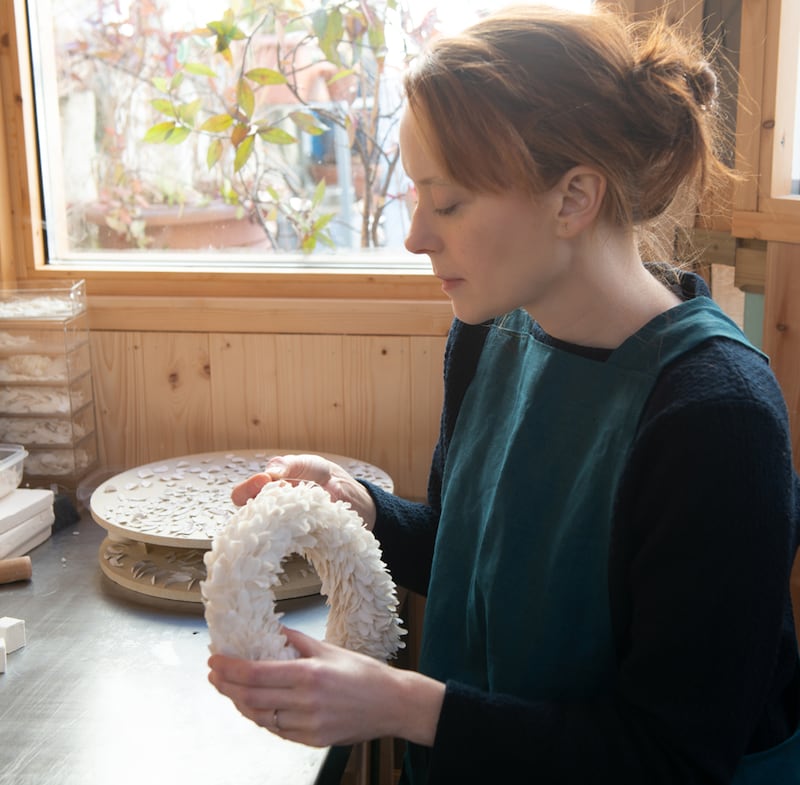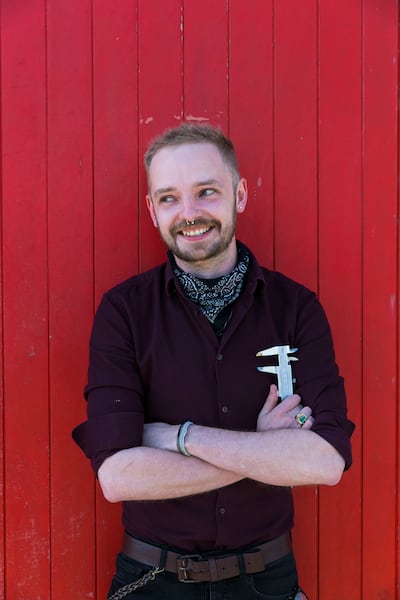Last year, 2021, marked the 50th anniversary of the Design and Craft Council of Ireland. To celebrate their half century, the council commissioned various projects to showcase some of its makers, both past and present. An element of that project is a new book, Irish Craft Heroes, 50 Makers x 50 Years.
Some of those featured makers who contributed so much to this country’s design during that period are now gone. The wood-turner Liam Flynn; died 2017. The ceramicist Sonja Landweer; died 2019. The jeweller Rudolf Heltzel; died 2020. But as some makers leave forever, in the way of life, others arrive. The book has a short section titled Future Lights, which profiles 10 makers in a number of mediums.
Future Lights is a rather peculiar description for these 10, many of whom are already extremely accomplished and successful. It’s surely more a term associated with younger or newly qualified people, who have shown promise, but are only starting out in their career. That is not the case here. At least two of these featured Future Lights, Jennifer Hickey (42) and Emma Bourke (38), already have their bright lights shining, with decades of work behind each of them. The implication is: how long must a maker toil at their craft in Ireland before being formally recognised as part of the current canon?

Jennifer Hickey (42), ceramicist
In common with many of those profiled here, ceramicist Jennifer Hickey went to NCAD. “I have been working with clay since leaving college,” she says. “I work only in porcelain. Materiality is everything. I love the ethereal, delicate aspect of porcelain; it is almost translucent. It looks very fragile and delicate but it also has great strength.”
READ MORE
Hickey’s pieces are composed from literally thousands of tiny leaf-like porcelain structures. She pierces each one before they are fired in the kiln, and then sews them together with translucent thread on to tulle. The finished effect is confoundingly gorgeous; they look like floating feathers. She displays them on little plinths.
“I’m trying to capture an emotion in clay,” she explains. “There is a stillness and beauty in each piece I make. I try to capture a vulnerability in each piece.”
Hickey recently moved to Louisburgh in Co Mayo, where she is establishing a studio. Her work is mostly bought by collectors, and she shows extensively outside Ireland. The pieces range in size from seven centimetres in diameter to 20 centimetres, and each is unique. They sell for between €900 and €5,500. jenniferhickey.com

Mark Newman (29), jeweller
“I went to NCAD to become an art teacher, but I got a taste for the craft of making,” says jeweller Mark Newman. “I really enjoyed having something physical at the end of it all. I had studied metalwork in secondary school, and loved working with my hands.”
It’s accurate to say most artists have a keen visual sensibility. Creating work involves imagining how it will look. Most artists also spend time looking at other work, or seeking out visual images for inspiration. They probably take it so much for granted that they don’t even think about it, but they rely on it innately. But Newman’s brain does not work like that.
“I have a condition called aphantasia,” he explains. I look up the definition as he is talking. “The inability to form mental images of objects that are not present.”
“I don’t have any visual imagination,” he says. “If I try to think of a past memory, I don’t get a visual.” Aphantasia is not something I had ever heard of before, and it seems to me like a uniquely challenging condition for anyone to have, let alone an artist.
“I can’t describe a person for the life of me. The best way to describe the condition is to say I’m like a computer but the screen is turned off. The good thing is people with this condition don’t get post-traumatic stress disorder, because we don’t get disturbed by disturbing images. I could try my best to imagine a piece of my work, but I can’t see it until it is made,” Newman says, adding he was asked to leave his degree course because his progress there at one point was so fractured.
So how has he found a way to work as a jeweller, making his own pieces; a process which involves design? “I make my own little algorithms, and rules,” he explains. “A lot of my stuff looks like a mathematical challenge.”
Newman’s pieces of jewellery are both beautiful and technical-looking, or geometric: necklaces that resemble metro maps or circuit boards; rings that look like golden Lego. He calls himself a “conceptual goldsmith” who makes “miniature sculpture. They are not your everyday pieces.”
He sells via commissions or exhibitions, and his pieces range in price from €1,200 to €12,000. marknewmanjewellery.com

Emma Bourke (38), glass-maker
“What I love about glass is the transparency of it, and the way you can add colour,” glass-maker Emma Bourke says. Bourke makes botanical-themed sculptures from “lamp-worked” glass: a more robust type of glass used to make scientific instruments. “It’s not like blowing glass, which you have to do all in one go,” she explains. “With lamp-working, you are working with a small torch, and you can go back to the piece again.”
Bourke makes tiny glass wild flowers and plants, all of which have medicinal stories behind them. The pieces are beautiful, delicate, and have a haunting quality to them. I make all the element separately and then assemble them together.” She used to display them as they were, but after three separate occasions when members of the public touched them in galleries and broke them, she now encloses them in little glass globes. “You are not meant to touch them, but people kept touching them.”
She is currently working on a series of tea-strainers, which will incorporate other materials, such as silver and wood. Her work is mostly bought by collectors.
Hugo Byrne (32), knife-maker
“How did I become a knife-maker? It began as an interest in making,” says Hugo Byrne. “Both of my parents are artists, and there was always a huge emphasis on making things when I was growing. [Byrne’s father is ceramicist Mike Byrne, and his mother is artist Mary Nagle.] When you graduate art school, you end up running off a cliff. I was waiting tables for a few years afterwards.”
Byrne went to Letterfrack in Co Galway to do an internship in conservation. “One of the things they were working on at that time was Michael Collins’s revolver.” Conservation Letterfrack specialises in the conservation of fine furniture and joinery. They were also working on restoring a choral lectern that had come from Adare Manor.
He was given some wood and assigned the task of designing three chopping boards. “I found myself thinking abut the knives that were going to be used on them. I felt like I was trying to design a cart without the horse. I was thinking about design as opposed to art; something with a function in mind.”
Byrne asked if he could design both a knife and a chopping board. His tutors directed him to the on-site library, which had several books on metalwork and forging. “I made my first three knives, and the chopping boards fell by the wayside. They never happened.”
After that, he continued to hone the craft of knife-making. “It’s both metalwork and woodwork. It has to look good, but it also has to function well. The challenge is to make something beautiful that works.”
All Byrne’s knives are kitchen knives: ie, not table knives. He uses bog oak for handles, and plastic that comes in from the ocean, and wood from windfelled trees. “You can never tell how the grain of a wood is going to behave once you start working on it.”
He buys metal from Britain. The blades are made of high-carbon steel, which, unlike stainless steel, changes colour over time. “It patinates with use. The levels of acidity in the food reacts with the steel. The colour it becomes is directly related to the person using it.”
His knives range from a 10 centimetre blade, which is the size of a fruit peeling knife, to 21 centimetres, the size of a carving knife. Prices range from €200 up to €800, and they are all made to order. “I’m working through a waiting list at the moment,” he says. “I work in batches of six knives, but they could all be different. If nothing goes wrong, I can make six in a week.” hugobyrneknives.com

Alan Meredith (31), wood-turner
“I started working with wood in secondary school, and kept at it,” says wood-turner Alan Meredith “I like the actual intimacy of the process; working directly with the material. The piece emerges quite quickly.”
He made a spinning wheel for his Leaving Cert project. “I started off making bowls, and spindle legs for furniture.” Now he works with Irish oak, mostly making sculptural vessels. “When I have pieces turned I steam bend them.”
Meredith points out that wood-turning is still seen as more of a hobby-based craft. “You can do a degree in ceramics but you can’t do a degree in wood turning, to my knowledge.” He thinks it may have something to do with the fact that the collectors’ market for ceramics is well-established, but it’s not — yet — the same for wood-turning.
His pieces sell for between €800 and €3,000, and are particularly sought after by interior designers. alanmeredith.ie
There are an additional five “Future Lights” selected for Irish Craft Heroes. Karen Donnellan is a glassmaker; karendonnellan.com. Pierce Healy makes “subversive jewellery”; piercehealystudio.com. Cecilia Moore makes sculpture from copper, bronze and silver; Ceciliamoore.ie. Helen O’Shea is a textile artist; helenoshea.ie. Annemarie Reinhold is a silversmith; annemariereinhold.com













